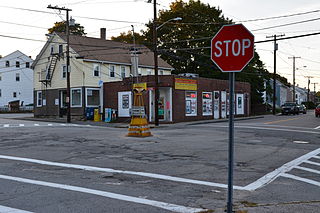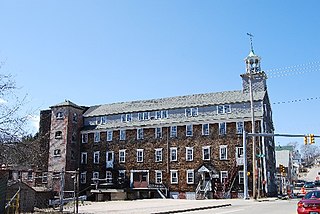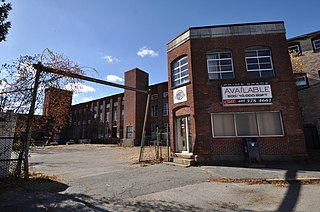
West Warwick is a town in Kent County, Rhode Island, United States. The population was 31,012 at the 2020 census.

The Moshassuck River is a river in the U.S. state of Rhode Island. It flows 8.9 miles (14.3 km) from the town of Lincoln to the city of Providence. There are six dams along the river's length.

The Blackstone Canal was a manmade waterway, linking Worcester, Massachusetts, to Providence, Rhode Island, and Narragansett Bay, through the Blackstone Valley, via a series of locks and canals in the early 19th century. Construction started in 1825, and the canal opened three years later. After the opening of the Boston and Providence Railroad (1835), the canal struggled for business. Its transportation role was taken over by the Providence and Worcester Railroad, which completed a parallel line in 1847. The canal shut down in 1848. Several segments of the canal are preserved, and the canal alignment and remains are on the National Register of Historic Places.

The Woonasquatucket River, sometimes called "the Woony", is a river in the U.S. state of Rhode Island. It flows approximately 15.8 miles (25.4 km) and drains a watershed of 130 km2 (50 sq mi).

The Slater Mill is a historic water-powered textile mill complex on the banks of the Blackstone River in Pawtucket, Rhode Island, modeled after cotton spinning mills first established in England. It is the first water-powered cotton spinning mill in America to utilize the Arkwright system of cotton spinning as developed by Richard Arkwright.

The Roger Williams National Memorial is a landscaped urban park located on a common lot of the original settlement of Providence, Rhode Island, established by minister Roger Williams in 1636. The national memorial commemorates the life of Williams, who co-founded the Colony of Rhode Island and Providence Plantations and championed religious freedom. The park is bounded by North Main, Canal, and Smith Streets, and Park Row.

The West River is a river in the U.S. state of Rhode Island. It flows approximately 7.6 miles (12.2 km) and is the only named tributary of the Moshassuck River. It has a history of providing water to textile mills during the Industrial Revolution as evidenced by the 7 dams along the river's length.

Smith Hill is a neighborhood in Providence, Rhode Island. Its traditional bounds are the Woonasquatucket River, the Chad Brown public housing complex, Interstate 95 and West River.

This is a list of the National Register of Historic Places listings in Providence County, Rhode Island.

Albion is a village and historic district in Lincoln, Rhode Island, in the United States.

Saylesville is a village and historic district in Lincoln, Rhode Island.

Allendale Mill is a historic mill at 494 Woonasquatucket Avenue in North Providence, Rhode Island, on the banks of the Woonasquatucket River.

Allenville Mill Storehouse is a historic mill storehouse at 5 Esmond Street in Esmond, Rhode Island within the town of Smithfield, Rhode Island. The exact date of construction is unknown, but it was built with rubble masonry construction which was typical of mill construction during and after the War of 1812. In 1813, Phillip Allen purchased 4.5 acres of land and constructed a mill on the site, but the first record to specifically refer to the storehouse was an insurance policy from 1836. Allen sold the property in 1857 and it changed ownership several times before it became Esmond Mills in 1906. In 1937, the building was used as a post office and described erroneously as the "Old Allenville Mill". The building has had some alterations to the front door and possibly the addition of a side door, but the interior of the structure was not detailed in the National Register of Historic Places nomination. The Allenville Mill Storehouse was added to the National Register of Historic Places in 1972.

Woonsocket Rubber Company Mill is an historic mill at 60-82 Main Street in Woonsocket, Rhode Island. The mill consists of a series of 3- and 4-story brick buildings built between 1865 and 1875 by Edward Harris, one of Woonsocket's leading businessmen. These buildings housed the Woonsocket Rubbert Company, one of Rhode Island's first manufacturer of rubber products, principally shoes, boots, and rubberized fabric. In 1910 the complex was purchased by the Falls Yarn Company, which used it for the production of fine woolen yarns.

The Woonsocket Company Mill Complex is a historic district encompassing one of the largest mill complexes in Woonsocket, Rhode Island. The district includes all of the buildings historically associated with the Woonsocket Company, a major manufacturer of cotton textiles in the 19th century. The complex is located along the eastern bank of the Blackstone River between Court and Bernon Streets. It includes three handsome stone mills, built between 1827 and 1859, and a power plant that was built on the site of the former #3 mill between 1890 and 1920, as well as the remnants of the canal that originally carried water to the buildings for power.

The Valley Falls Mill is a historic textile mill complex on Broad Street in Central Falls, Rhode Island. The complex consists of the primary mill building, a large Italianate brick four-story building erected in 1849, several outbuildings. a dam across the Blackstone River, and a portion of the original canal system which provided water power to the mill. The outbuildings include the gatehouse controlling waterflow into the canals, a small stuccoed office building now serving as a retail establishment, and a brick bathhouse built c. 1870 that stands just south of the mill race. The complex originally had a second mill building and power canal; that building was destroyed by fire, and its canal was filled in. The main mill building was developed as housing in the late 1970s, including a sympathetic replacement for the second mill building.

The Lippitt Mill is an historic mill at 825 Main Street in West Warwick, Rhode Island.

The Broadway–Armory Historic District is a historic district encompassing a mainly residential mixed-used urban area west of downtown Providence, Rhode Island.

The Lymansville Company Mill is a historic industrial complex at 184 Woonasquatucket Avenue in North Providence, Rhode Island. The oldest portion of the complex, a three-story brick building which originally a textile spinning and carding building, was built in 1884. The mill was significantly expanded in subsequent years, with its last addition taking place in 1951. The Lymansville Company was founded in 1884 and closed in 1957. Auguste Albert Sack, the leading partner in the company, was a German immigrant with significant work experience in New England's textile industry.
John Smith was a founding settler of Providence in what would become the Colony of Rhode Island and Providence Plantations. Smith joined Roger Williams at the Seekonk River in 1636 after both were expelled from Massachusetts Bay Colony. In the spring they crossed the river to found Providence where Smith later built and operated the town's gristmill.



















